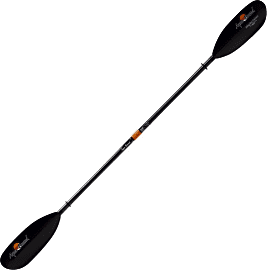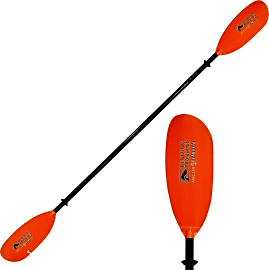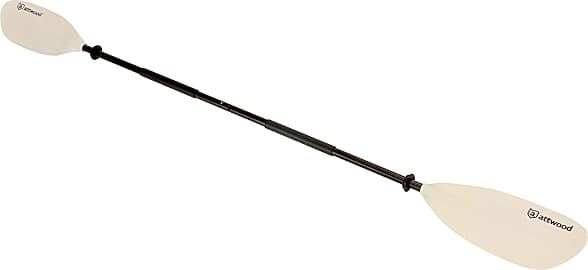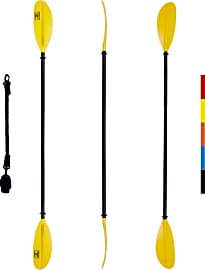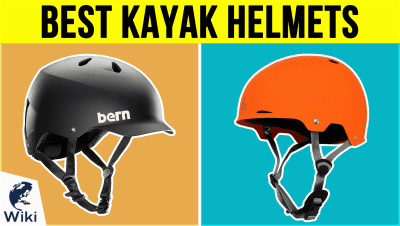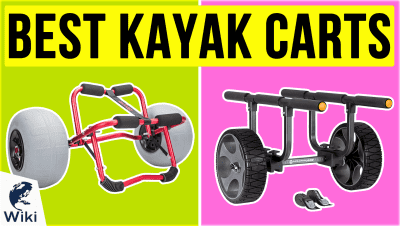The 10 Best Kayak Paddles

This wiki has been updated 43 times since it was first published in September of 2015. You don't ever want to be up a creek without one, so make sure you peruse our selection of kayak paddles and choose the right option for your next aquatic adventure. They come in a variety of sizes and styles, from low-angle to high-angle models, and are made from a range of materials, from plastic to carbon fiber, ensuring there's something for every skill level and budget. When users buy our independently chosen editorial selections, we may earn commissions to help fund the Wiki.
Editor's Notes
December 02, 2020:
In this round of updates, we increased the amount of top-end selections and introduced some ultra-lightweight options, such as the Wilderness Systems Pungo and the Aqua Bound Sting Ray. Both of these models sport carbon fiber shafts and blades, though the former does offer a fiberglass variation for those who prefer it. Coming in at over a pound heavier, the Werner Camano caught our eye due to its blade design, which can assist the user in furthering their distance without exerting themselves unnecessarily. The Carlisle Magic Plus retained a place on our list as it's considerably less expensive than all of the aforementioned suggestions, however, it's not as light as the top picks, nor does it have as good a ferrule system.
We were sure to maintain a budget offering in our selection by adding the Attwood 11768-2, which is ideal for beginners. The grip area of this selection is particularly good, but at only 213 centimeters (84 inches) it falls slightly short of conventional adult paddles. That said, if you have a torso of roughly 28 inches this will be a good size for you. For a longer length, the Oceanbroad Unisex offers 230 centimeters (approx. 90 inches) and is in a similar price bracket. We retained the SeaSense Xtreme II, which is longer again, as another affordable pick as it sports many of the features of a more advanced model: it's rather light, and the blades can be feathered at three angles. Unfortunately, the connection of the two halves can be a little wobbly, and occasionally the grips may shift when in use. This is not something that will bother a newbie, but more seasoned kayakers will probably find the experience quite underwhelming.
For water-loving youngsters, the Carlisle Kids is a suitable scaled-down version that will be easier to control compared to the rest of our choices. The shaft is thinner and therefore better-suited to small hands, while the length is a mere 190 centimeters (approx. 75 inches) so it's less cumbersome for little ones to maneuver. If you are thinking of taking your children out on the water, be sure to outfit them and yourself with proper safety equipment first, such as a life vest and a helmet.
May 17, 2019:
Whether you're heading out for some leisurely cruising at your local lake or preparing to navigate wilder waters, you're sure to find a kayak paddle to suits your needs on this list. We combed through over two dozens models while putting it together, and made sure to select a wide enough variety to cover all experience levels and aquatic applications. The SeaSense Xtreme II, for example, is perfect for casual paddles out on the bay or in other marine environments, while the Werner Skagit CF is compact and rugged enough to hold up during aggressive white water adventures. Overall, we thought the Carlisle Magic Plus best for most people, since its versatile design and sturdy fiberglass construction make it perfect for recreational kayaking of any sort.
How To Choose The Right Kayak Paddle
At the very ends of many kayak paddle shafts you will find two discs called drip rings that help keep water from running down toward the paddler.
To the dedicated kayaker, the sport is not even called kayaking, but rather is referred to as paddling. Indeed, after the boat itself, the paddle is far and away the most essential piece of gear the paddler owns and uses. In tandem with your own muscles and motion, the kayak paddle is your propulsion system, your rudder for steering, and your best line of defense against rocks, hanging branches, floating debris, and any other obstacles that stand in your way during a paddling trip downriver or out on open water.
First, let's take a moment to cover the terminology used in discussing kayak paddles. The long central tube of the paddle is called the shaft, with the outer few inches of both sides of the shaft -- the parts that actually dip into the water -- known as the throat. Many paddlers refer to the sections of the shaft just inside the throats as the grips, as these are areas where your hands will wrap around the shaft.
At the very ends of many kayak paddle shafts you will find two discs called drip rings that help keep water from running down toward the paddler. And finally, at each end of a kayak paddle, you will find the all-important blades. These are the propellers and rudders of your swift, sleek craft, and are of the utmost importance. The vaguely concave side of the blade, the face that will push through the water, is known as the power face.
When choosing a kayak paddle, the primary concern for most paddlers is its overall length, the proper measure of which is determined relative to user height (or, for the more technically minded paddler, by torso length -- this level of specificity is hardly required, though). A paddler who is less than 5'5" should use a paddle measuring about 215cm or a bit less. A paddler who is between 5'5" and 5'11" will be best served by a kayak around 220 to 225cm. And a paddler who is 6' or taller should look for a paddle measuring 225 to 230cm or even slightly longer, depending on how and where it will be used.
Note that kayak paddles are always measured using the metric system, so don't confuse inches and centimeters.
When in doubt, choose a slightly smaller paddle for use during whitewater kayaking. The reduced length of the paddle will give you more room to maneuver it around your boat and the obstacles in the river, while the smaller blades won't much impact your forward motion, thanks to the rushing river's current carrying you along anyway.
If you are more of an open water kayaker, usually plying the swells of an ocean, bay, or lake, then it's a good idea to get a longer paddle with plenty of surface area on both blades. While a long, large paddle can be a liability when you are trying to deftly dodge and turn in the exciting environment of whitewater, on open water, there's plenty of room for your paddle on either side of the kayak, and the increased surface area of the blades means more propulsion through the water.
A Few Words On Proper Paddling Technique
Far too often, amateur kayakers tire themselves out (and risk back, shoulder, and arm strain) based on improper paddling technique. Proper paddling is more of a core exercise -- using the many strong muscles of your torso, chest, and abs working in concert -- than it is a burning workout for your biceps and deltoids.
Simply trail the paddle in the water on the side toward which you want to turn for a gentle shift, or paddle backward on that same side for a more dramatic tack.
To paddle properly, first focus on posture. You should be facing directly forward in your boat, with your legs outstretched and your feet resting against the foot pegs or against the hull of the craft. Your knees should be bent slightly and never locked. Sit upright, keep your shoulders relaxed and fluid, and don't press against the backrest or the cockpit rim.
Next make sure you are gripping your paddle with your hands in the proper area of the shaft just inside from the throat sections. When paddling, one of your arms should be bent at around a fifty degree angle while the other is nearly straight, with this straight arm held forward and stabbing the blade into the water quickly.
Try to generate maximum force during the first few feet of each stroke, relaxing as the blade passes your body in the water and then removing it to dip and pull on the alternate side. With your legs bracing you in place and your core doing most of the work to move your arms past you, your arms should remain strong and relaxed even for long paddling sessions.
Turning a kayak is an easy and natural motion. Simply trail the paddle in the water on the side toward which you want to turn for a gentle shift, or paddle backward on that same side for a more dramatic tack.
A Few Facts About Paddling
A kayak is one of the fastest human-powered watercraft on earth. While covering flat water for shorter distances, a single rower in a skull can achieve faster speeds than most kayakers, kayaks are significantly faster than canoes. And given the ease with which a kayak can handle rough water conditions that would best any rowing boat and even most open canoes, kayaks come out on top for distance travel over choppy open water or down rivers with rapids.
While under most circumstances, the average cruising speed of a kayak is accepted to be three knots (newcomers to the hobby will likely paddle at close to two knots), the actual theoretical top speed of a kayak can be determined by a mathematical equation. By taking the square root of the kayak's hull length where it meets the waterline and multiplying it by 1.34, you can determine a boat's top speed. So an eighteen-foot kayak with a waterline of sixteen feet would have a top speed of 5.36 knots. This is considered the top speed because above this pace, the kayak would begin to plane, rising out of the water and sacrificing speed and control.
Different kayak lengths and designs can buck this equation, though, in the hands of an expert. The current world record for distance covered by a kayaker in a single day is 155 miles and was achieved by Carter Jonson in 2013. His record indicates an average causing speed of 6.45 miles per hour, or almost twice the top speed of an amateur paddler.


